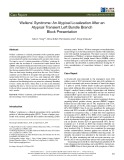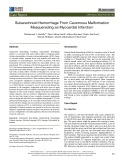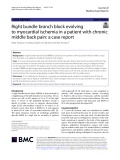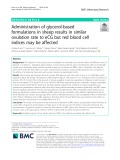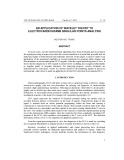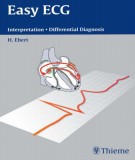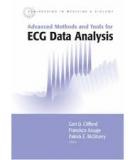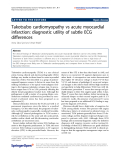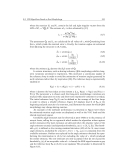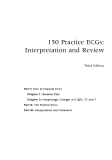
ECG changes
-
Wellens’ syndrome is a clinical presentation with a particular pattern of electrocardiographic (ECG) T-wave changes associated with critical, proximal left anterior descending (LAD) coronary artery lesions.
 5p
5p  viintuit
viintuit
 26-09-2023
26-09-2023
 2
2
 0
0
 Download
Download
-
Intracranial hemorrhage, including subarachnoid hemorrhage (SAH), is associated with many cardiac effects, including cardiac rhythm abnormalities, ischemic electrocardiographic (ECG) changes, elevated cardiac troponin levels, and regional wall motion abnormalities on echocardiogram.
 6p
6p  viwhitewolf
viwhitewolf
 03-07-2023
03-07-2023
 4
4
 2
2
 Download
Download
-
A right bundle branch block (RBBB) is rarely found in patients with myocardial infarction (MI). In addition, back pain is an atypical complaint in patients with angina. It is a challenge for clinicians to recognize and carefully assess a patient’s complaints even if they are admitted for pain that is “atypical” of MI. When ECG shows changes, clinicians need to pay attention to a tricky, hidden, and life-threatening occlusion of the coronary artery.
 5p
5p  vidoctorstrange
vidoctorstrange
 06-05-2023
06-05-2023
 3
3
 2
2
 Download
Download
-
The objective of this study was to investigate the metabolic and osmotic effects of different doses of glycerol or a glycerol – propylene glycol mixture in Sarda sheep with the aim to identify those able to beneficially modify ewe’s metabolic status without harmful changes in red blood cell (RBC) indices.
 15p
15p  vigandhi
vigandhi
 23-02-2022
23-02-2022
 9
9
 1
1
 Download
Download
-
Cardiovascular comorbidity in COPD is common and contributes to increased mortality. A few population-based studies indicate that ischemic electrocardiogram (ECG)-changes are more prevalent in COPD, while others do not.
 9p
9p  vimontana2711
vimontana2711
 05-04-2021
05-04-2021
 15
15
 2
2
 Download
Download
-
In this paper, a report is made on an application of the mentioned capability of wavelet transform for grasping subtle changes and discontinuities in electrocardiogram (ECG) signals. From the signal processing point of view, it shows that the diagnostic of ECG signals is carried out by excluding any recognised abnormality as singular points or irregular structures.
 10p
10p  dannisa
dannisa
 14-12-2018
14-12-2018
 20
20
 0
0
 Download
Download
-
(BQ) Continued part 1, part 2 of the document Easy ECG: Interpretation - Differential diagnosis presents the following contents: Coronary heart disease and myocardial infarction, other ECG changes. Invite you to consult.
 44p
44p  thangnamvoiva4
thangnamvoiva4
 01-07-2016
01-07-2016
 44
44
 3
3
 Download
Download
-
(BQ) The document divided into three sections, the first part presents the basic principles of ECG and normal and abnormal ECG patterns. The following chapters describe ECG changes in different heart diseases, emphasising efficiency and fluency in interpreting the patterns. The final section provides 150 ECG tracings for trainees to practise and interpret on their own.
 167p
167p  thangnamvoiva4
thangnamvoiva4
 01-07-2016
01-07-2016
 44
44
 3
3
 Download
Download
-
(BQ) The third edition of ECG in Medical Practice has been fully revised to provide trainees with the latest advances in ECG, helping them recognise, interpret and diagnose cardiac abnormalities. Part 1 of the document presents the following contents: Basic concepts of ECG, ECG changes in different diseases.
 120p
120p  thangnamvoiva4
thangnamvoiva4
 01-07-2016
01-07-2016
 50
50
 2
2
 Download
Download
-
Chief complaint: Reason for admission to the ICU. History of present illness: This section should included pertinent chronological events leading up to the hospitalization. It should include events during hospitalization and eventual admission to the ICU. Prior cardiac history: Angina (stable, unstable, changes in frequency), exacerbating factors (exertional, rest angina). History of myocardial infarction, heart failure, coronary artery bypass graft surgery, angioplasty. Previous exercise treadmill testing, ECHO, ejection fraction.
 150p
150p  ozon_ozon
ozon_ozon
 03-05-2012
03-05-2012
 70
70
 8
8
 Download
Download
-
In order to address these issues, we have attempted to detail many of the key relevant advances in signal processing. Chapter 1 describes the physiological background and the specific autonomic mechanisms which regulate the beat-to-beat changes of timing and morphology in the ECG, together with the cause and effect of breakdowns in this mechanism. Chapter 2 presents an overview of the primary issues that should be taken into account when designing an ECG collection system.
 390p
390p  ozon_ozon
ozon_ozon
 02-05-2012
02-05-2012
 94
94
 19
19
 Download
Download
-
Syed and Khalid International Journal of Emergency Medicine 2011, 4:17 http://www.intjem.com/content/4/1/17 LETTER TO THE EDITORS Open Access Takotsubo cardiomyopathy vs acute myocardial infarction: diagnostic utility of subtle ECG differences Asma Saba Syed and Umair Khalid* Abstract The clinical findings of Takatsubo Cardiomyopathy and acute myocardial infarction can be very similar. While Takatsubo cardiomyopathy rarely leads to severe complications, acute myocardial infarction can be life threatening.
 2p
2p  dauphong13
dauphong13
 09-02-2012
09-02-2012
 57
57
 5
5
 Download
Download
-
Trong những tình huống nhất định, chẳng hạn như trong thời gian thiếu máu cục bộ, QRS hình thái hiện vật biến đổi lâu dài không liên quan đến hô hấp. Điều này thúc đẩy một cập nhật liên tục của vòng tham khảo để tránh việc lập dự toán của các góc quay được tạo ra bởi các biến thể như vậy chứ không phải là hô hấp
 40p
40p  kimku12
kimku12
 27-10-2011
27-10-2011
 84
84
 4
4
 Download
Download
-
150 Practice ECGs: Interpretation and Review Third Edition Part I: How to Interpret ECGs Part II: 150 Practice ECGs Chapter 1: Baseline Data Part III: Interpretation and Comments Chapter 2: Morphologic Changes in P, QRS, ST, and T For Marilyn 150 Practice ECGs: Interpretation and Review Third Edition George J. Taylor, MD Professor of Medicine The Medical University of South Carolina The Ralph H. Johnson VA Medical Center Charleston, South Carolina, USA © 2006 George J. Taylor Published Blackwell Blackwell Blackwell by Blackwell Publishing Ltd Publishing, Inc.
 27p
27p  kimku12
kimku12
 27-10-2011
27-10-2011
 82
82
 20
20
 Download
Download
-
Pulmonary Embolism (See also Chap. 256) Chest pain due to pulmonary embolism is believed to be due to distention of the pulmonary artery or infarction of a segment of the lung adjacent to the pleura. Massive pulmonary emboli may lead to substernal pain that is suggestive of acute myocardial infarction. More commonly, smaller emboli lead to focal pulmonary infarctions that cause pain that is lateral and pleuritic. Associated symptoms include dyspnea and, occasionally, hemoptysis. Tachycardia is usually present.
 5p
5p  ongxaemnumber1
ongxaemnumber1
 26-11-2010
26-11-2010
 66
66
 2
2
 Download
Download
CHỦ ĐỀ BẠN MUỐN TÌM








